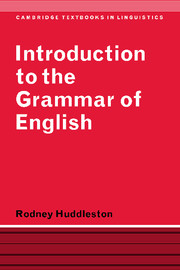Book contents
- Frontmatter
- Contents
- Preface
- Table of symbols and notational conventions
- 1 Basic concepts in grammar
- 2 The structural approach to linguistic analysis
- 3 The parts of speech
- 4 Verbs and verb phrases
- 5 The structure of kernel clauses
- 6 Nouns and noun phrases
- 7 Pronouns
- 8 Adjectives and adjective phrases
- 9 Verbs, nouns and adjectives: the boundaries between them
- 10 Adverbs, prepositions and conjunctions
- 11 Clause type
- 12 Coordination and subordination
- 13 Negation
- 14 Thematic systems of the clause
- References
- Index
6 - Nouns and noun phrases
Published online by Cambridge University Press: 05 June 2012
- Frontmatter
- Contents
- Preface
- Table of symbols and notational conventions
- 1 Basic concepts in grammar
- 2 The structural approach to linguistic analysis
- 3 The parts of speech
- 4 Verbs and verb phrases
- 5 The structure of kernel clauses
- 6 Nouns and noun phrases
- 7 Pronouns
- 8 Adjectives and adjective phrases
- 9 Verbs, nouns and adjectives: the boundaries between them
- 10 Adverbs, prepositions and conjunctions
- 11 Clause type
- 12 Coordination and subordination
- 13 Negation
- 14 Thematic systems of the clause
- References
- Index
Summary
Nouns
The most central members of the word-class noun have the following three properties:
(a) Functional potential, I. They function as head in the structure of NPs, NPs in turn realise a variety of functions, notably (but not exhaustively) subject, object or predicative complement in clause structure, complement in PP or PossP structure.
(b) Functional potential, II. As heads of NPs, they take a different range of dependents from the other parts of speech. Most distinctively, they take determiners like the, which, a, every, my, three (the book, my cousin, three days) and adjectives as pre-head modifiers (young boys, valuable paintings).
(c) Inflection. They enter into inflectional contrasts of number, singular vs plural (dog vs dogs, cousin vs cousins).
The first property can be said to be the most general, inasmuch as all nouns function as head in NP structure – there is no close analogue of auxiliary verbs, which we have analysed as functioning only as dependent in VP structure. Properties (b) and (c) characterise only central nouns, with marginal members differing from them in varying degrees here. Notice in particular that there are quite a few words belonging uncontroversially to the noun class which do not have plural counterparts (equipment, furniture, wetness), and some without singular counterparts (alms, dregs, remains): it is for this reason, and also because there are fewer inflectional contrasts, that we have given somewhat less weight to inflection in the characterisation of nouns than we did for verbs.
- Type
- Chapter
- Information
- Introduction to the Grammar of English , pp. 227 - 271Publisher: Cambridge University PressPrint publication year: 1984



